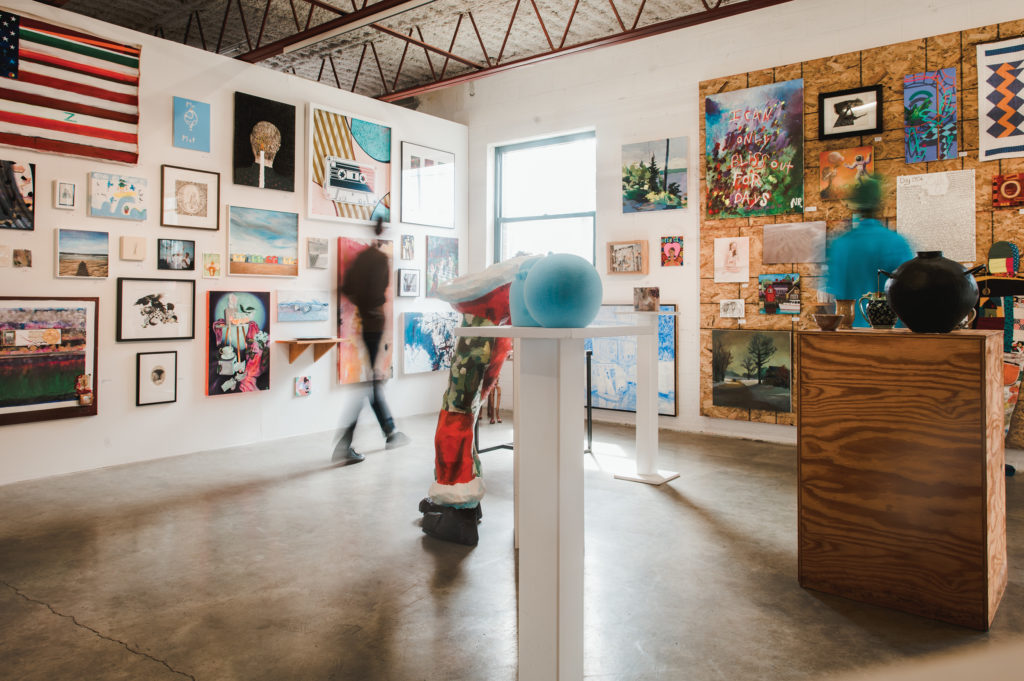Contemporary Meets Community at a Kittery Art Gallery
Buoy Gallery is a blank canvas for art of all kinds.

On a rainy day in early spring, downtown Kittery is emerging from a dormant winter. Careful shoppers look at tiny ritual bells and herbal tinctures at Yarrow, and a wide-spaced line forms for coffee and crullers at Lil’s Cafe. Folk boutique is about to open after a break, and bars and restaurants like the Wallingford Dram and the Black Birch are in a state of active, anticipatory cleanup. In the background, the faint silhouette of the Portsmouth Naval Shipyard looms over Wallingford Square.
This sense of potential energy breaks into pure action at Buoy, Kittery’s 12-year-old contemporary art mainstay. Al Mead, the gallery’s visionary founder, welcomes visitors into the large, bright space with open arms. “Hi, hello, come right in!” he says to a small group of people, including artist Hannah Bevens, who has work in the gallery. They have scheduled an appointment to visit ArtPM, Buoy’s annual open-call exhibition, which has become legendary in southern Maine and seacoast New Hampshire.

ArtPM is Buoy’s most anticipated yearly event. Every spring the gallery space fills with over 300 individual works by local and national artists. Children’s art is juxtaposed with that of award-winning contemporary painters; conceptual sculpture abuts pen-and-ink illustrations; and the close spacing of the work lends Buoy— normally an airy, spacious venue—a powerful sense of visual noise. This cacophonous installation encapsulates Mead’s generosity as a gallerist, and his sense of the breadth of the visual arts community in the region. “I have a really expanded sense of the local,” Mead says. “The connection between the Maine and New York art worlds is at least 100 years old.”
Originally from Kittery Point, Mead studied sculpture at Allegheny College, studies that included a semester abroad at the renowned Nova Scotia College of Art and Design. Modularity was a key principle in his artwork, and his dedication to envisioning space as a flexible container has allowed him to transform Buoy again and again. In contrast to ArtPM, solo shows at Buoy tend toward the spare and enigmatic, such as Whip-poor-will, Justine Kablack’s recent show of conceptual sculpture and small narrative black-and-white drawings. Then, when the space is used for live music, it transforms again into a site of buzzing energy. For the Kittery-Portsmouth area, with no formal art museum and relatively few venues to view contemporary art, Buoy stands out as a beacon to those who are invested in experiencing (and exhibiting) visual art.

Mead and a few artist and musician friends first opened the space in 2008. “We were trying to make a room that was just about the work,” he says, “and really reacting against exclusivity.” The resulting gallery has been shaped by this desire to let artwork speak for itself, while also being guided by the influence of the wider community. The Kittery-Portsmouth area has long been home to a strong music scene, and Buoy has hosted musicians such as Tune-Yards, Ryan Power, and Little Wings. The visual art presented at Buoy veers between high-level conceptual work—a solo exhibition of Baxter Koziol’s experimental fabric constructions opens June 18, followed by shows featuring New Hampshire painter Chad Etting in August and Maine sculptor Duncan Hewitt in June 2022—and community-based events such as ArtPM and pop-up fundraisers for local artists in times of need. Mead’s habitual modularity allows for flexible programming and keeps the exhibitions both dynamic and connected to the community. “It’s a rhizoming reach; it just keeps branching,” Mead says of the gallery’s trajectory. “We have so many incredible artists living in the area. But I also see the local art community as something broader.” He adds, “To me, Rockland is local. And there are ‘local artists’ who live in New York and Los Angeles, too.”

The open spirit of Buoy stands in contrast to a polarized art world, where the appreciation of contemporary art can be seen as addressing a narrow elite and occasionally a provincial suspicion of the avant-garde emerges. ArtPM, on the other hand, attracts a wide cross-section of artists and viewers. In 2020 its opening coincided with the pandemic shutdowns in mid-March. “I just flooded social media with images. It was all I could do,” Mead says. “No one could come to the gallery, and we had almost 350 pieces in the show. All I could do was take pictures. It was a whole new thing for us.” For the past year, the exhibitions at Buoy have continued to hover between a heavy social media presence for visibility and limited in-person gallery visits. Concerts have stopped altogether. “Honestly, you don’t know what you’ve got till it’s gone,” Mead says. “The community around this gallery is way more spread out than a local art association, and I miss having people just stop by.”
The early-spring rainy-day scene at Buoy remains colorful and bright. The group of artists has left, and Mead’s partner, Rachel Holland Ouillette, a textile archivist and designer, pops in and out. Another small group, including artist Maegan Dolan, who also has work in ArtPM, arrives for an appointment, this time from New York City. “Nice to see you! Come in, come in!” says Mead, gesturing a warm welcome from a safe distance.







